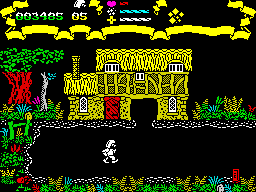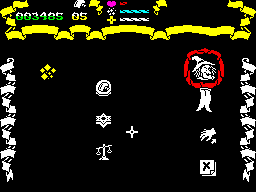
With two recent CRASH Smashes, for Quazatron and Pyracurse, already under its collective belt, the folks at Hewson are limbering up to deliver another three body blows to the software charts before Christmas. Hannah Smith and Bill Scolding have been looking at Firelord, Uridium and City Slicker, and they spoke to the brains behind the games...
Steve Crow, author of the hugely successful Starquake and Wizard’s Lair, is the latest top programmer to join the creative and prolific team at Hewson. His first game for them is the soon-to-be-released Firelord.
Firelord is set in the deceptively quaint medieval land of Torot. Ramshackle half-timbered dwellings line the cobbled streets, and fairy tale woods fringe the town. It’s all a bit like Ludlow, really, without the traffic wardens and yellow binbags!

Steve based a lot of the buildings on houses in his home county of Kent, and points out that some of the dwellings have peculiar funnels protruding from the roof slates. ‘Those are Kent cast houses, for the local hops. Which is why there are so many pubs in the village...’ In fact, the idea behind Firelord grew out of the graphics. Steve was doodling around on his screen and came up with a neat little rustic town house. He did a few more, and the scenery for Firelord was created. The plot came later.
And what of the plot? Well, all is not well in Torot. The Wicked Queen has tricked the local fire-breathing dragon into parting with the secret of his blazing breath, the Firestone. With this in her possession she begins to terrorise the inhabitants of Torot in a way that a dragon could only fantasise about.
Into this dangerous situation stumbles Sir Galaheart. Being a knight, and fearless into the bargain, he has vowed to search the land for the four elements of the spell of eternal youth. Sir Galaheart knows a thing or two about Evil Queens and reckons that she will gladly trade the Firestone for this youth-giving spell.

However, when Sir Galaheart enters Torot he makes a macabre discovery. All the inhabitants have vanished. So frightened are they of the Queen and her dreaded Firestone — which she uses with great zest — that they refuse to come outside their houses. Torot is instead populated with flame ghosts who romp around the countryside creating all sorts of havoc.
The last thing the ghosts want is for the Firestone to be returned to its rightful owner. As soon as Sir Galaheart begins his quest they swarm all around him, draining his essential energy. These irritating ghosties can be destroyed, but Sir Knight must first find the enchanted crystal. Once he has this, he can fire bolts of power at his assailants and protect his energy levels.
No knight has ever stayed fearless for very long on an empty stomach, so regular meals must be sought. Luckily for Sir Galaheart, the land of Torot is well-stocked with edibles, and nibblets can be picked up along the way. Every time Sir G stumbles across the odd foodstuff his energy goes up to maximum again and his appointment with the Grim Reaper is postponed once more.

Charms and grub apart, there are other useful objects lying around. These can be used for trading with the locals in return for even more useful things. Many houses around Torot have open doors. If Galaheart enters one of these he is faced with a choice of objects which he can barter for. If he’s desperate, he can try stealing something when the occupier isn’t looking. However, if he is caught in the process he must stand trial. An arrow alternates between innocent and guilty and you must stop it moving when it’s pointing to ‘innocent’. Otherwise the punishment is death and our gallant knight loses one of his four lives.
Not one for making things too easy, Steve Crow has thrown in a few other hazards for good measure. Fireballs dropped by the Queen spring up in Galaheart’s path and contact with them results in death, predictably enough.
There’s a lot more to Firelord than all this, and quite a few things which are not explained in the instructions, as is fairly usual in Steve’s games. Steve is putting the final touches to the game now — ‘a few more locations and the music’ — and when it’s complete, the game will have 512 screens of questin’, killin’, eatin’ and barterin’. Enough to keep you occupied when the winter knights are drawing in. Look out for Firelord on or around October 29. It’ll cost a paltry £8.95.
Hugely successful on the C64, Uridium is now being converted for the Spectrum by another newcomer at Hewson, Dominic Robinson.
Originally designed and written by Andrew Braybrook, the Spectrum version of Uridium retains the same scenario: you are the pilot of a Manta fighter. Out in the depths of space, vast alien Dreadnaughts silently move into orbit around each planet in the sector, preparing to drain minerals from the planets’ cores to feed their interstellar power drives.
Piloting the versatile little fighter, your task is to zoom over the hull of each Dreadnaught wiping out its ancillary craft and then crippling the mother ship. In all, there are fifteen of these space leviathans to disable, and they’re not just going to sit there while you take potshots at them — fighter craft are out in force.
Although you’re obviously outnumbered, the Manta has been equipped with the latest technology. A powerful laser is quite capable of destroying alien fighters. And boy, do those little blighters shift, wave upon wave swooping in at varying horrendous speeds.

Even if you’re successful in breaking through the defensive screens of enemy craft, flying in over the Dreadnaught hulls will test your nerves and skill to the limit. The flanges and ducts of the ship bristle with transmitter masts and require some tricky sidestepping. Sheer walls and protrusions suddenly leap into your line of vision and it’s sometimes necessary to veer off at right-angles to pass through tiny gaps.
If you’re still airborne and have been actively attacking the Dreadnaughts for several death-defying minutes, then the words ‘Land Now!’ flash up at the top of the screen. It’s time to negotiate your way to the other end of the Dreadnaught and set the Manta down on the master landing strip. Then the vast bulk of the Dreadnaught can be destroyed and its shattered particles sent spiralling into the cosmos.
There’s scarcely time for a breather before the Manta has to be sent screaming into the next wave of alien craft and Dreadnaught number two. Dominic Robinson is currently toying with the idea of putting in a bonus level between Dreadnaughts, awarding extra points for the waves of fighters which have been blasted, the destruction of the Dreadnaught itself, and number of Mantas you still have in reserve. Also, the finished version should boast a two player option, with each player having three lives. Points are awarded for knocking alien fighters out of the air, blasting apart surface features on the hull and destroying ships parked on the Dreadnaught. An extra Manta is given every ten thousand points.
Dominic reckons the biggest headache in converting Uridium has been getting the graphics systems to work at all, and then making it sufficiently fast: ‘It’s taken about ten different versions to get something which approaches a proper emulation of the Commodore game, and even then memory restrictions have meant we’ve had to sacrifice some of the Dreadnaught graphics which appeared in the original. Though each Dreadnaught will have a different design and layout, some of the chains and twisted links, which connected parts of the ship in the C64 game, have had to go.’
When we spoke to Dominic, the game was about a month away from completion, with only the first few Dreadnaught mother ships in place. Hopefully, by the release date — October 28 — Uridium will contain 15 Super-Dreadnaughts, as in the Commodore version. Each ship will be more difficult to get through than the one before.... £8.95 should pay for a lot of fast and furious action!
While Messrs Crow and Robinson have been dreaming up past and future worlds, Steve Marsden and David Cooke have been feverishly beavering away on a game based around everyday life in London town. You know the kind of thing: Arab terrorists, football hooligans, bombs in the Houses of Parliament...
The game’s called City Slicker, and the Marsden/Cooke partnership has so far taken the game through three versions, with the programming getting steadily slicker and slicker. We’re on version Mk II(a) right now.
The game originally featured a number of London landmarks — yer Nelson’s column, yer Post Office tower, yer actual Buck house — connected by grubby tube trains. Slick, the ‘off beat tec’, had to shuttle from one location to another, hot on the trail of the Arab terrorist, Abru Caddabra.

Slick tricks from Lincoln-based programming team, Steve Marsden and David Cooke...
Much of this has gone now. Instead of the finely detailed screens which we had a sneak look at when we visited Marsden and Cooke in mid-August — the exterior of the Houses of Parliament was spread across three screens, every window and crenellation present — City Slicker is now played out on platforms and levels inside four locations only: the Tower of London, the British Museum, the Houses of Parliament, and Buckingham Palace.
‘The outdoor scenery didn’t play very well,’ explains Steve. ‘It’s very much a room game, like Technician Ted, with the difference that instead of abrupt screen changes, the program flips half of one room and half of the next, so there’s a sort of inbetween screen as you exit one room and enter another.’
Lost also are the animated characters of important personages — Mrs Thatcher himself, and those loony but lovable Royals. ‘It was just too wasteful of memory, having specific sprites only required for certain locations. Animated characters which could roam from room to room had to go too; they’re now tied to specific rooms.’ All except Slick and Abru, that is.
But enough of what might have been. City Slicker Mk II is still stuffed with action and delightful details. Take the opening screens, for instance. As your Spectrum does a passable imitation of the clickerty-clack of a moving tube train, we see the profiles of Slick and Abru through the carriage window. Abru quickly sprays some graffiti on the glass, and slides out of sight, while Slick vows to get him.
The plot is straightforward. The Arab terrorist has planted a bomb in the visitors’ gallery of the House of Commons, set to detonate at midnight, and Slick must assemble the eight components of the defusing device and get it to the bomb in time. Even then you’re not finished — Cooke and Marsden have added one more trial of skill which we won’t reveal.

The bits and pieces of the disposal unit are, predictably, scattered all over the shop, often in places that can only be reached by shunting objects around from one room to another. Slick can leap acrobatically about, but his range depends on the energy level at the bottom of the screen. Colliding with unfriendly characters reduces energy; discovering foodstuffs increases it by the nutritional value of the food consumed. Pep pills replenish energy by 100 per cent, and you have three of these held in reserve. Use them wisely.
Objects can be picked up, stood on and dropped, and that includes some mobile thingies. If you can’t operate a toggle switch to open a door, sometimes another character can be persuaded to do it for you. In one of the early locations, in the Tower of London, a disposal component is located beneath a closed trapdoor. Finding a ton weight, several rooms away, and taking it back to trapdoor allows you to smash your way through. Steve says ‘there’s a million and one strategies like that in the game’.
If the going gets tough, the tough start looking for a cheat mode. There is one in City Slicker, and it works like this: pause the game, and type in the code word. The screen will display a series of room numbers, and toggling to left and right will allow you to select the location you want. Easy, ain’t it? Except you’ve got to discover the code word...
If you run out of energy and pep pills, or if the clock strikes midnight, or if you run into Abru himself, then the game ends. You are then treated to a spectacular grand finale, as the bomb shatters the Seats of Government. It takes about 30 seconds, and the screen is full of exploding pixels. Almost worth dying for.
City Slicker will be out on November 25, just missing Guy Fawkes’ Day by a week or three. It’ll be priced at £8.95.